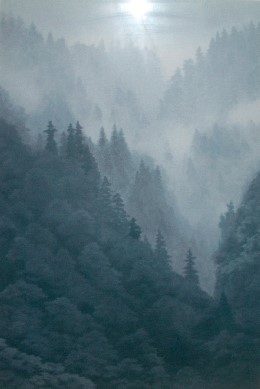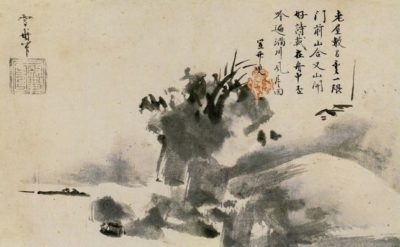Yūgen and Landscape Painting

Painting is among the Japanese aesthetic practices referred to as geidō. Geidō 芸道 literally means “the way of art” and refers to the mental practice of emphasizing the techniques and philosophies behind traditional Japanese art disciplines, in effect appreciating and honoring the process of creation itself . . . whatever the artist is trying to make. One of the sinographs of geido is dao (道), indicating the philosophic/religious goals of the practices. To recognize how these goals were approached in painting practice, is to uncover the Daoist roots of Zen Buddhism influence in Japanese art and culture.
Sesshū Tōyō (雪舟等楊, 1420–1506) was a seminal Japanese artist at a time when philosophic/religious practices of Chan Buddhism gave rise to Zen Buddhism and Japanese artists moved to develop their own indigegous art tradition seeking purely aesthetic ideals. Landscape painting was central to that development. While Sesshū was a celebrated painter, poet, calligrapher, and gardener, his landscapes, particularly the “Splashed Ink Landscape” epitomize the yūgen aesthetic. (See Japanese Aesthetics Part.4 – Yūgen: Mysterious Grace).

The “splashed ink” (hatsuboku) technique Sesshū employed, was one of several spontaneous “broken ink” (haboku) techniques including washes and splashes, ink-flinging, and dripping. The most demanding style, “splashed ink” was considered the highest form of expression and required mastery of bodily movements that created the work, much like the highly stylized movements of No drama the renown Japanese theatre tradition. To move according to the dao is to move with the natural spontaneity of a being freed of the restrictive “self”. To move with natural spontaneity is also the expression of another well-known Daoist concept called wuwei 無爲, or “non-action”; which is to move beyond the egoic binary scheme of activity and passivity.
Thus, landscape painting offered a unique opportunity for painters such as Sesshū, to manifest the yūgen aesthetic. The invitation to focus on the process of creation, and the produced images not fully formed, disrupt the habitual “story-telling” of the human ego, and a glimpse of our oneness with the continuous motions of nature gleams through the rift.
Come Visit Art De Tama Fine Art!
Japanese artist in the United States. Tamao Nakayama was born and raised in Tokyo, Japan, and moved to the U.S. when she was 25 years old. She is still deeply influenced by the Japanese aesthetic, and the belief that ‘less is more’. She is a minimalist abstract artist. She paints and sculpts.
